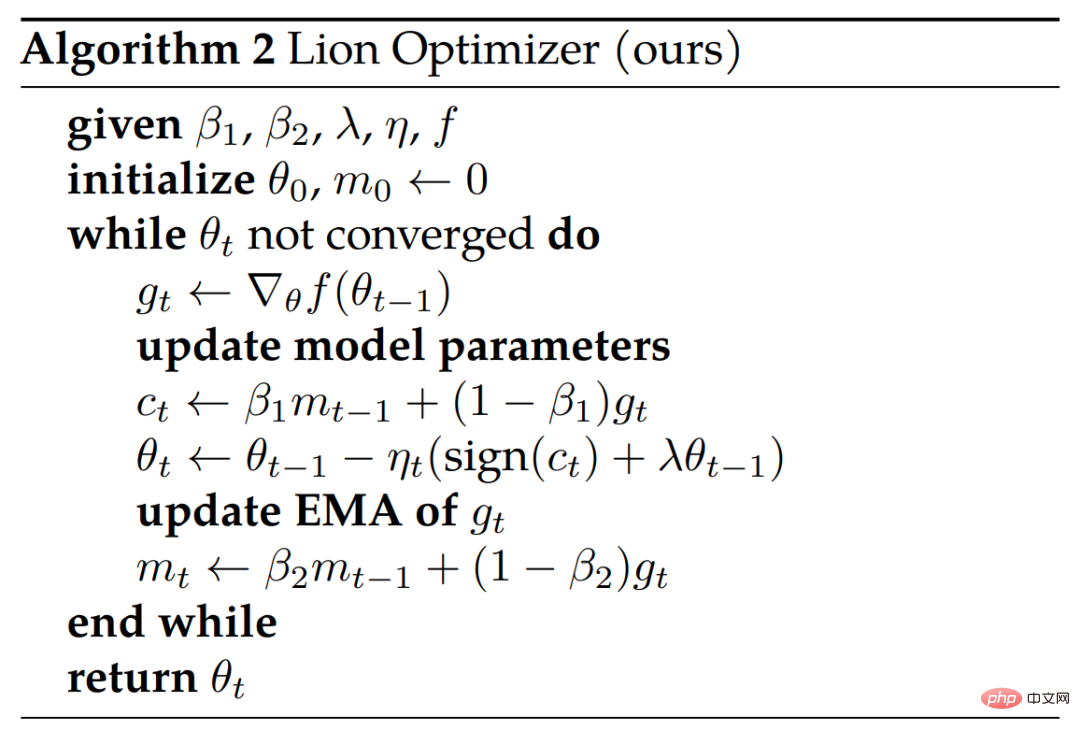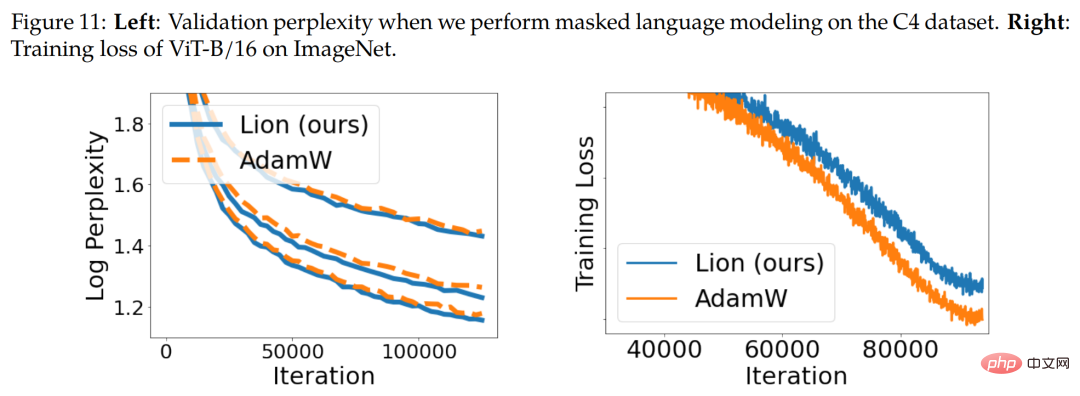
The optimizer is an optimization algorithm and plays a key role in neural network training. In recent years, researchers have introduced a large number of manual optimizers, most of which are adaptive optimizers. Adam and Adafactor optimizers still occupy the mainstream of training neural networks, especially in the fields of language, vision and multi-modality.
In addition to manually introducing optimizers, another direction is for the program to automatically discover optimization algorithms. Someone has previously proposed L2O (learning to optimize), which discovers optimizers by training neural networks. However, these black-box optimizers are usually trained on a limited number of small tasks and have difficulty generalizing to large models.
Others have tried other approaches, applying reinforcement learning or Monte Carlo sampling to discover new optimizers. However, in order to simplify the search, these methods usually restrict the search space and thus limit the possibility of discovering other optimizers. Therefore, current methods have not yet reached SOTA level.
In recent years, it is worth mentioning AutoML-Zero, which attempts to search every component of the machine learning pipeline when evaluating tasks, which is very useful for the discovery of optimizers.
##In this article,Researchers from Google and UCLA propose a method to discover optimization algorithms for deep neural network training through program search, and then discover Lion(EvoLved Sign Momentum) optimizer. Achieving this goal faces two challenges: first, finding high-quality algorithms in the infinitely sparse program space, and second, selecting algorithms that can generalize from small tasks to larger, SOTA tasks. To address these challenges, the research employs a range of techniques, including evolutionary search with hot starts and restarts, abstract execution, funnel selection, and program simplification.
Xiangning Chen, the first author of the paper, said: Our symbolic program search found an effective optimizer that only tracks momentum - Lion. Compared with Adam, it achieved 88.3% zero-sample and 91.1% fine-tuned ImageNet accuracy, as well as up to 5x (compared to ViT), 2.3x (compared to diffusion model) and 2x (compared to LM). ) training efficiency.

In addition, Lion reduces the pre-training computation on JFT by up to 5 times, improves the training efficiency of diffusion models by 2.3 times, and achieves better FID scores, It also provides similar or better performance in language modeling, saving up to 2 times the computational effort.
Twitter user crumb said: He used Google's Lion optimizer to train a 124M parameter GPT2 model and found that the number of steps required to achieve the same loss as Adam was reduced by 37.5%.

## Source: https://twitter.com/aicrumb/status/1626053855329898496
Symbolic Discovery of AlgorithmsThis paper uses symbolic representation in the form of a program to have the following advantages: (1) It conforms to the fact that the algorithm must be executed as a program fact; (2) compared to parametric models such as neural networks, symbolic representations such as programs are easier to analyze, understand, and transfer to new tasks; (3) program length can be used to estimate the complexity of different programs, making it easier to choose a more Simple, often more versatile program.This work focuses on optimizers for deep neural network training, but the approach is generally applicable to other tasks.
In the figure below, Program 2. This simplified code snippet uses the same signature as AdamW to ensure that the discovered algorithm has a smaller or equal memory footprint; Program 3 is given Example representation of AdamW.

This research adopts the following techniques to address the challenges posed by infinite and sparse search spaces. First, regularization is applied because it is simple, scalable, and successful in many AutoML search tasks; second, it is to simplify the redundancy in the program space; finally, to reduce the search cost, this study reduces the model size and the number of training examples by and steps away from the target task to reduce costs.
Left: Shown are the means and standard errors of five evolutionary search experiments. Right: Both the percentage of redundant statements and the cache hit rate increase as the search progresses.
Derivation and analysis of LionResearchers stated that the optimizer Lion has simplicity, high memory efficiency, and powerful performance in search and meta-validation. .
Derivation
The search and funnel selection process led to Program 4, which was derived from the original Program 8 (Appendix ) is obtained by automatically deleting redundant statements. The researcher further simplified and obtained the final algorithm (Lion) in Program 1. Several unnecessary elements were removed from Program 4 during the simplification process. where the cosh function is removed since m will be reallocated in the next iteration (line 3). Statements using arcsin and clip were also removed because the researchers observed no loss of quality without them. The three red statements are converted into a symbolic function.
Although m and v are used together in Program 4, v only changes the way the momentum is updated (two interpolation functions with constants ∼0.9 and ∼1.1 are equivalent to one with ∼ 0.99 function) and does not need to be tracked separately. Note that the bias correction is no longer needed as it does not change the direction.


Symbol updating and regularization. The Lion algorithm produces updates with uniform magnitude in all dimensions through symbolic operations, which is different in principle from various adaptive optimizers.Intuitively, symbolic operations add noise to updates, act as a form of regularization and aid generalization. Figure 11 below (right) shows one piece of evidence.

Momentum tracking. The default EMA factor for tracking momentum in Lion is 0.99 (β_2) compared to the 0.9 commonly used in AdamW and momentum SGD. This choice of EMA factors and interpolation allows Lion to strike a balance between remembering 10 times the history of the momentum gradient and putting more weight on the current gradient in updates.
Hyperparameter and batch size selection. Compared to AdamW and Adafactor, Lion is simpler and has fewer hyperparameters since it does not require ϵ and factorization related parameters. Lion requires a smaller learning rate, and thus a larger decoupled weight decay, to achieve a similar effective weight decay strength (lr * λ).
Memory and runtime advantages. Lion only saves momentum and has a smaller memory footprint than popular adaptive optimizers like AdamW, which is useful when training large models and/or working with large batch sizes. For example, AdamW requires at least 16 TPU V4 chips to train ViT-B/16 with an image resolution of 224 and a batch size of 4,096, while Lion only requires 8 (both with bfloat16 momentum).
In the experimental part, the researchers evaluated Lion on various benchmarks, mainly comparing it with the popular AdamW (or when the memory becomes Adafactor at bottleneck) for comparison.
Image Classification
Researchers perform experiments covering various datasets and architectures on image classification tasks . In addition to training from scratch on ImageNet, they also pre-trained on two larger mature datasets, ImageNet-21K and JFT. Image size defaults to 224.
First train from scratch on ImageNet. The researchers trained ResNet-50 for 90 epochs with a batch size of 1,024, and the other models for 300 epochs with a batch size of 4,096. As shown in Table 2 below,Lion significantly outperforms AdamWon various architectures.
Secondly, pre-train on ImageNet-21K. The researchers pre-trained ViT-B/16 and ViT-L/16 on ImageNet-21K for 90 epochs with a batch size of 4,096. Table 2 below shows thatLion still outperforms AdamWeven if the training set is expanded 10 times.

Finally pre-train on JFT. In order to push the limits, researchers conduct a large number of experiments on JFT. Figure 4 below shows the accuracy of three ViT models (ViT-B/16, ViT-L/16 and ViT-H/14) under different pre-training budgets on JFT-300M. Lion enables ViT-L/16 to match the performance of AdamW’s ViT-H/14 trained on ImageNet and ImageNet V2, but at 3x lower pre-training cost.

Table 3 below shows the fine-tuning results, with higher resolution and Polyak averaging . The ViT-L/16 used by the researchers matches the results of ViT-H/14 previously trained by AdamW, while having 2x fewer parameters. After extending the pre-training dataset to JFT-3B, Lion-trained ViT-g/14 outperforms previous ViT-G/14 results with 1.8x fewer parameters.
Visual language contrastive learning
This section focuses on CLIP style visual language contrastive training. Rather than learning all parameters from scratch, the researchers initialized the image encoder using a powerful pre-trained model.
For Locked Image Text Tuning (LiT), the researchers compared Lion and AdamW on LiT by training text encoders in a comparative manner using the same frozen pre-trained ViT. Table 4 below shows the zero-shot image classification results at 3 model scales, with Lion demonstrating continued improvement over AdamW.

Figure 5 (left) below shows an example zero-shot learning curve of LiT-B/16-B, and Similar results were obtained on the other two datasets.

##Diffusion model
Recently, diffusion models have achieved great success in image generation. Given its huge potential, we tested Lion on unconditional image synthesis and multimodal text-to-image generation.
For image synthesis on ImageNet, the researchers used the improved U-Net architecture introduced in the 2021 paper "Diffusion models beat gans on image synthesis" to perform 64×64 on ImageNet , 128×128 and 256×256 image generation. As shown in Figure 5 above (middle and right), Lion can achieve better quality and faster convergence on FID scores.
For text-to-image generation, Figure 6 below shows the learning curve. Although there is no significant improvement on the 64 × 64 base model, Lion outperforms AdamW on the text-conditional super-resolution model. Lion achieves higher CLIP scores and has smaller noisy FID metrics compared to AdamW.

#Language Modeling and Fine-tuning
This section focuses on language modeling and fine-tuning. On pure language tasks, researchers found that adjusting β_1 and β_2 can improve the quality of AdamW and Lion.For autoregressive language modeling, Figure 7 below shows the token-level perplexity of Wiki-40B and the word-level perplexity of PG-19. Lion consistently achieves lower verification perplexity than AdamW. It achieves speedups of 1.6x and 1.5x when training medium-sized models on Wiki-40B and PG-19, respectively. PG-19 further achieves a 2x speedup when the model increases to large size.



The study also uses four popular optimizers RAdam, NAdam, AdaBelief and AMSGrad to train ViT-S/16 and ViT-B/16 on ImageNet (using RandAug and Mixup). As shown in Table 7 below, Lion remains the top performer.

The above is the detailed content of Completely crush AdamW! Google's new optimizer has small memory and high efficiency. Netizens: Training GPT 2 is really fast. For more information, please follow other related articles on the PHP Chinese website!




